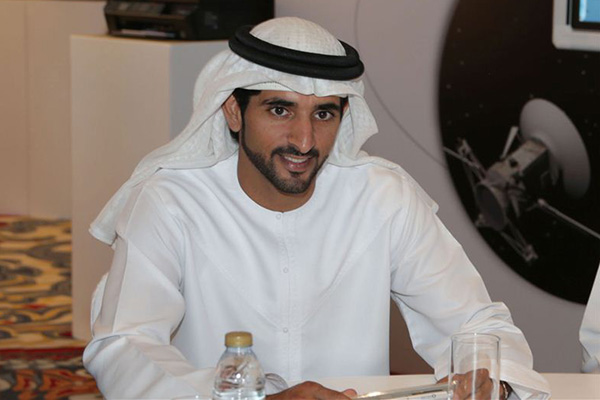
Hamdan bin Mohammed: Major milestone in UAE’s
ambitious space programme
UAE launches first nanosatellite into space
DUBAI, February 16, 2017
The Mohammed bin Rashid Space Centre (MBRSC) and the American University of Sharjah (AUS) have announced the successful launch of Nayif-1, the UAE's first nanosatellite launched into outer space yesterday (February 15).
The launch occurred at 7.58 in the morning (UAE local time). Nayif-1 takes on added importance as an educational project launched by MBRSC in cooperation with AUS with the goal of providing hands-on experience to Emirati engineering students on designing, building, testing and operating nanosatellites.
Sheikh Hamdan bin Mohammed bin Rashid Al Maktoum, Crown Prince of Dubai, chairman of MBRSC described the successful launch of Nayif-1 as an important step on the road towards implementing the UAE’s ambitious space programme.
“Yesterday we saw the launch of one of the most important space projects humanity has ever known, the ‘Mars 2117 Project’. This project reflects our leadership’s aim to make the UAE a pioneer in shaping humanity’s future and its determination to leave a positive mark on human development with innovative thinking and a determination to achieve success. With the launch of the new satellite, we are confident that we are on the right path for achieving new scientific breakthroughs with the efforts of UAE citizens,” he said.
The nanosatellite was launched on-board a PSLV-C37 rocket, from Satish Dhawan Space Centre in Sriharikota, India. On-board its rocket, this launch held around 104 satellites, making it historically the highest number of satellites to be launched together. Nayif-1 was the 5th satellite separated from the launch vehicle after the main payload.
The ground station, located at the AUS, received the first signal from Nayif-1 18 minutes and 32 seconds after it reached its orbit. A team of engineers from MBRSC, the students who participated in the project, as well as MBRSC’s knowledge transfer partners, Innovative Solutions in Space, were present at the ground station during launch and early operations. Nayif-1 will be operated and controlled from the ground station at AUS moving forward.
Director general of MBRSC Yousuf Al Shaibani said: “The Nayif-1 project is only the first step in the MBRSC strategy geared towards introducing space projects for university students. We aspire to ensure the sustainability of educational space projects and we are determined to develop the capabilities of Emirati engineering students, as we believe that youth is the source from which both innovation and excellence flow. This is best exemplified by Nayif-1, which is the first 1U nanosatellite that is programmed to transfer messages in Arabic.”
Dr Bjorn Kjerfve, chancellor of AUS said: “The nanosatellite will be monitored by the ground station based at AUS. We are very pleased to have developed this project with MBRSC and look forward to future collaborations that will advance the skills and knowledge of AUS Emirati engineers in space technologies.”
Fatma Lootah, deputy project manager of Nayif-1 at MBRSC, said: “Nayif-1 passed over the ground station at 9.30 am, and we were able to successfully receive the first signal from the satellite and initially check its health and behaviour.”
“In its subsequent passes, we will continue to monitor the satellite to understand how it responds to commands in the daytime and in the evening; however it will be shifted later on to the autonomous mode. We will also verify the active control system board in Nayif-1, which determines the satellite’s direction and maintains its balance, especially as this is the first time this board has been used in a 1U nanosatellite (10*10*10cm),” Lootah added.
With regard to the satellite passes over the ground station, Hessa Al Matroushi, Deputy Project Manager of Nayif-1 at MBRSC, said: “Nayif-1 will pass over the ground station around four times a day, twice in the morning and twice in the evening. We’ll use the morning passes to evaluate the satellite’s health and behaviour; in addition, to sending and receiving text messages on Amateur Radio frequencies throughout the world. The night passes, on the other hand, are used specifically for sending and receiving messages”.
“Nayif-1’s mission goes beyond sending and receiving text messages on amateur radio frequencies, as it has several other scientific objectives, including characterising and validating the accuracy of a thermal model of Nayif-1 with in-situ temperature measurements in space, as well as determining the evolution of the solar cells performance in space during the mission design life,” Al Matroushi explained.
Nayif-1 was launched into a sun synchronous orbit at an altitude around 512 kilometres above the Earth. With dimensions of 10x10x11.35 cm3 and a weight of 1.32 kg, the CubeSat will produce a communication footprint of 5,000 km.
The milestone phases of the project, which took around a year and a half, were carried out at MBRSC under the supervision of its team of engineers and specialists.
Nayif-1’s knowledge transfer programme was implemented in partnership with Innovative Solutions in Space, one of the leading companies worldwide in the development of nanosatellite systems. MBRSC’s leadership of the Nayif-1 project ensured that all necessary processes were in place to preserve and build upon the experience gained. – TradeArabia News Service







